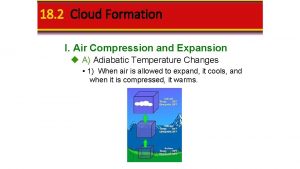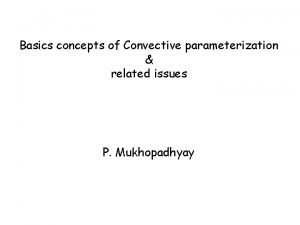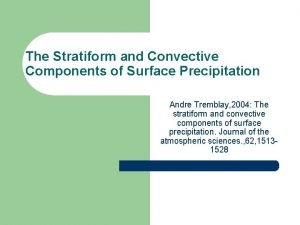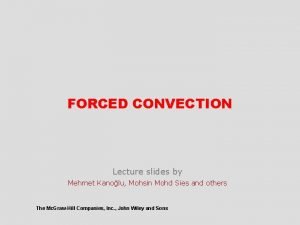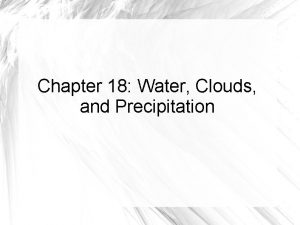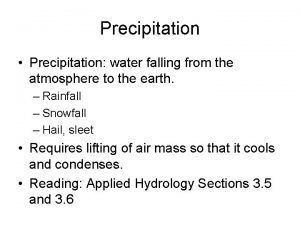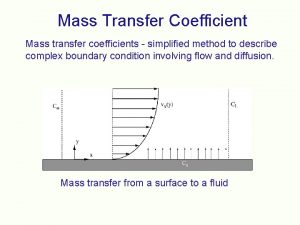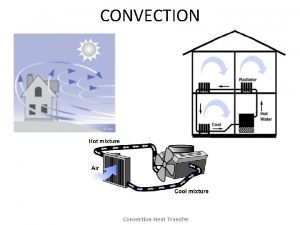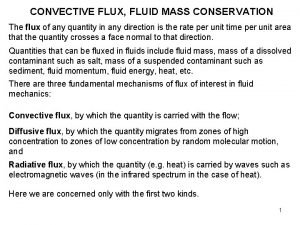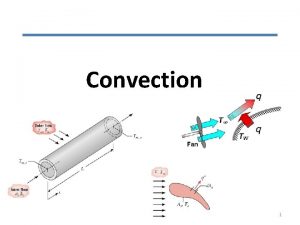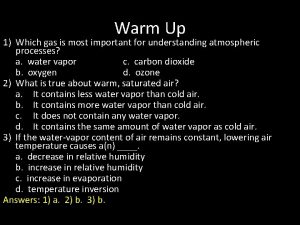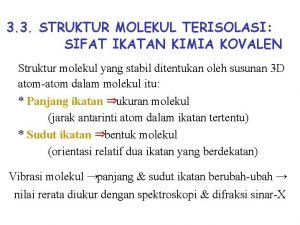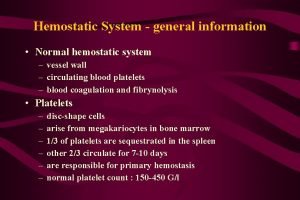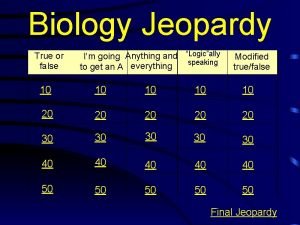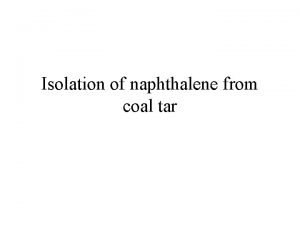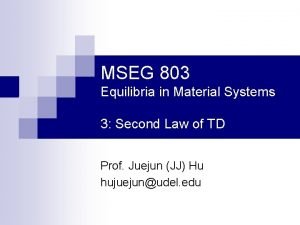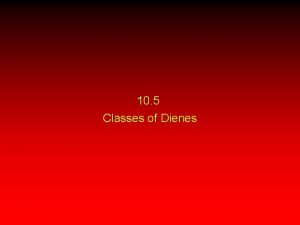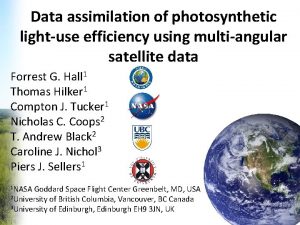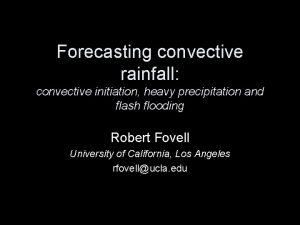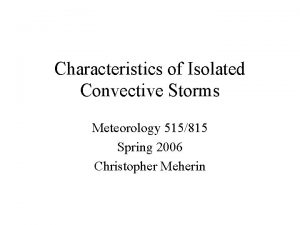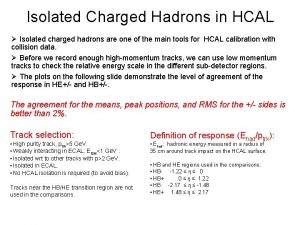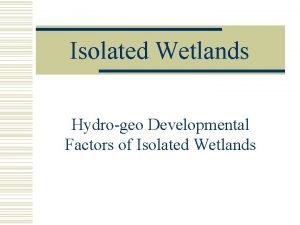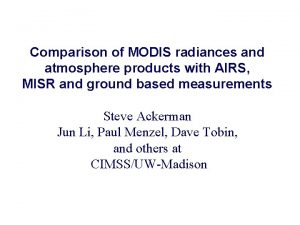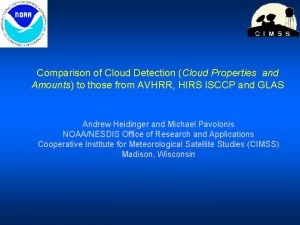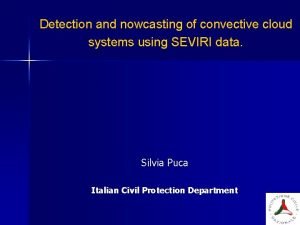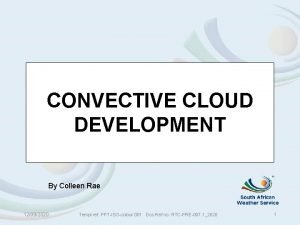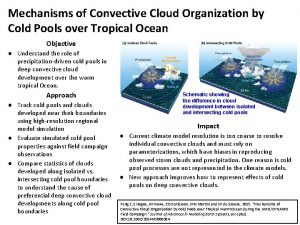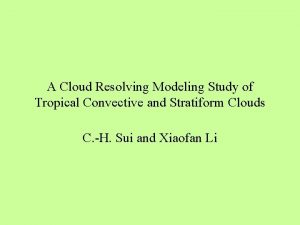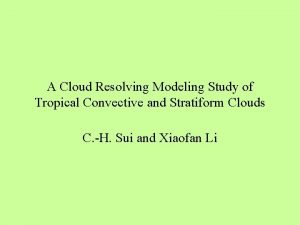Multiangular radiances of an isolated convective cloud comparison



























- Slides: 27

Multi-angular radiances of an isolated convective cloud: comparison between MISR measurement and Monte-Carlo simulation C. Cornet(1), R. Davies(2) (1) Laboratoire d’Optique Atmosphérique, Université de Lille, France (2) Department of physics , The university of Auckland, New Zealand 1. (1, 2) initially at the Jet Propulsion Laboratory, Pasadena, CA

Why studying deep convective cloud ? Deep convective cloud = high vertical extent large water content Satellite retrieval assumes an independent homogeneous cloud pixel = 1 D retrieval limitations in case of deep convective cloud: • often strong heterogeneity effects : - subpixel cloud variability - smoothing of the radiance field - brightness and shadowing effects 1 D retrieval leads to errors in the optical thickness determination • important vertical extent and large water content: - lost of energy by the cloud sides - asymptotic limit of radiances 1 D retrieval tends to underestimate the optical thickness

MISR: Multi-angle Imaging Spectro-Radiometer 9 view angles at Earth surface: 70. 5º, 60º, 45. 6º, 26. 1º forward/ aftward and 0º Multiple spectral bands at each angle: MISR/Terra: 446, 558, 672, 866 nm 400 -km swath: 9 -day global coverage 275 m - 1. 1 km sampling 7 minutes to observe each scene at all 9 angles

Deep convective cloud and MISR advantages: 9 cameras + high resolution (275 m) observation of the cloud sides and top September, 2 th, 2003 Pacific ocean: lat ~ 7°; lon ~ 180° • reconstruct cloud contour • compute radiances along the cloud to match MISR measurement

Cloud reconstruction Obtaining cloud top height and cloud position 1) Distance between a features seen with 2 cameras: 2) ∆D 2) Cloud top height calculation: CTH = ∆D / [tan ( 2 - 1)] (Xc, Yc) CTH 3) Parallax correction : Xc = Xg + CTH * tan( ) * sin ( ) Yc = Yg + CTH * tan( ) * cos ( ) D (Xg, Yg)

Cloud reconstruction Obtaining cloud top height and cloud position

Cloud reconstruction Comparison between stereographic and manual results Height ~ 8 km Thickness ~ 8 km Seiz and Davies, Rem. Sens. Env. , 2005

Cloud reconstruction Cloud envelop approximation Height ~ 8 km Thickness ~ 8 km

Mapping the radiances along the cloud Use camera direction to know radiances going out from the cloud Height ~ 8 km Thickness ~ 8 km

Mapping the radiances along the cloud

Radiances simulation Use a forward Monte-Carlo model based on : 1 ) the storage of the photon collision density 2 ) the integration along each line of sight increase the rapidity of the calculations Forward camera Geometrical configuration: sun: s= 22º s= 98 camera AN: = 0º camera AF, AA: = 22. 1º camera BF, BA: = 45. 6 camera CF, CA: = 60º camera DF, DA: = 70. 5º Forward: 160 º Aft: 340 º DF CF BF AF AN AA BA CA DA Aft camera 0º

Clear sky: MISR measurements Use MISR cloud mask for 200 x 200 km around the cloud: ~ 100 pixels s ~ 22º s ~ 278º

Clear sky: Monte-Carlo Simulation Wind speed = 2. 5 m. s-1 (Cox and Munk model, 1955) Raleigh molecular scattering: R=0. 042 Aerosol optical thickness: a=0. 09 Aerosol phase function: mixture between sea-salt and sulfate s ~ 22º s ~ 262º

Deep convective cloud : Monte-Carlo simulation - account for the cloud morphology + constant extinction coefficient (2, 5, 10 km-1) Extinction coefficient Radiances closest to the perpendicular of the cloud surface

Simulation with a constant extinction coefficient Radiances along the cloud for the 9 MISR camera

Simulation with acloud constant extinction coefficient Deep convective : Monte-Carlo simulation MISR radiances along the cloud Monte-Carlo simulation: cloud morphology + ext=10 km-1 + C 1 Phase function

Sensitivity to the phase function MODIS phase = mixed or uncertain + cloud top ≈ 8 km --> test phase function effects • IHM (Inhomogeneous Hexagonal Monocrystal; Labonnote et al. , JGR, 2001)�

Sensitivity to the phase function MISR radiances along the cloud Monte-Carlo simulation: cloud morphology + ext=5 km-1 + IHM phase function for z >= 6 km

Simulation with a variable extinction coefficient Use differences between measured and simulated An radiances to adjust horizontally the extinction coefficient.

Simulation with a variable extinction coefficient MISR radiances along the cloud Monte-Carlo simulation: cloud morphology + horizontally variable extinction � coefficient

Comparison between - radiances accounting for the cloud morphology (3 D) - radiances of an infinite homogeneous cloud (1 D) Simulation of the 1 D radiances for the 9 MISR cameras for different optical thickness

Comparison between 1 D/3 D radiances 1 D radiances + MISR measurement 1 D retrieval (4 km) 5 -10 ; (9 km) 10 -20; (11 km) 30 �

Comparison between 1 D/3 D radiances 1 D radiances + MISR measurement + 3 D simulation 1 D/3 D retrieval (4 km) 5 -10/54 ; (9 km) 10 -20/13; (11 km) 30/158 �

Sensitivity along the cloud sides ? 1 D radiances + MISR measurement + 3 D simulation Sensitivity of the radiances along the cloud sides is low

Retrieved 1 D/3 D optical thickness 1 D optical thickness 3 D optical thickness

Conclusion Thanks to MISR : - reconstruction of the contour of an isolated deep convective cloud - angular distribution of the radiances along the cloud surface Deep convective cloud: - Accounting for cloud morphology Higher optical thickness than the 1 D retrieval possible underestimation of the LWC - Low sensitivity for the side difficulty to retrieve the vertical cloud properties (for this configuration) Possible future: -� Reconstruction of a complete 3 D cloud - Use the angular distribution to develop of a method to retrieve cloud properties accounting for the morphology

Deep convective cloud : collision density cloud morphology + constant extinction (5 km-1) Sun=22º almost perpendicular to the cloud profile
 Clouds, fog, or dew will always form when
Clouds, fog, or dew will always form when Localized convective lifting
Localized convective lifting Convective parameterization
Convective parameterization Stratiform
Stratiform Convective heat transfer coefficient
Convective heat transfer coefficient Cumulus clouds
Cumulus clouds It is the water falling from the atmosphere.
It is the water falling from the atmosphere. Mass transfer equation
Mass transfer equation Convection (heat transfer)
Convection (heat transfer) Section 18.2 cloud formation
Section 18.2 cloud formation Convective sigmet
Convective sigmet Flux of fluid
Flux of fluid Introduction to convection
Introduction to convection Orographic lifting
Orographic lifting Convective clouds
Convective clouds Limit comparision test
Limit comparision test Isolated maternal hypothyroxinemia
Isolated maternal hypothyroxinemia Bilangan sterik
Bilangan sterik Memory mapped io diagram
Memory mapped io diagram Why do clouds form?
Why do clouds form? Megakariocytes
Megakariocytes Phil wharton active isolated stretching
Phil wharton active isolated stretching Biology jeopardy
Biology jeopardy Haworth synthesis of naphthalene
Haworth synthesis of naphthalene Isolated system
Isolated system Cumulated diene structure
Cumulated diene structure Types of stairs in building construction
Types of stairs in building construction Isolated feature combined feature effects
Isolated feature combined feature effects

